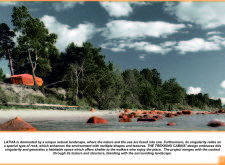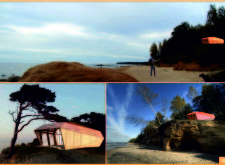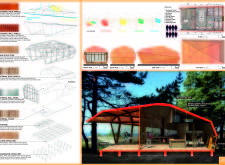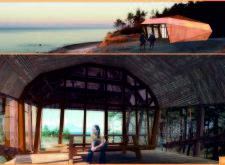5 key facts about this project
### Overview
The Trekking Cabins project is situated along the Latvian coastline, where the diverse natural landscape of sea and forest offers a rich backdrop. The design aims to facilitate a connection between occupants and the environment, providing a refuge for hikers and explorers venturing into the scenic terrain. The intent is to create accommodations that respect and enhance the surrounding landscape while promoting sustainability and user comfort.
### Spatial Configuration and Architectural Form
The cabins feature a geometric design characterized by angular forms that reflect the irregularities of the coastal topography. This contemporary approach merges functionality with aesthetics, allowing the structures to harmonize with their surroundings. The layout is systematically organized, distinguishing between public communal areas and private resting spaces, thereby catering to both social interaction and individual relaxation. Innovative storage solutions are incorporated to assist visitors in organizing their outdoor gear.
### Material Selection and Sustainability Strategies
The external materials prioritize sustainability and durability. A predominant use of renewable wood serves as a structural framework while providing a tactile connection to nature. Translucent polycarbonates in the roof and wall panels allow for natural light infiltration while ensuring protection from weather elements. Photovoltaic panels installed on the rooftops contribute to energy self-sufficiency, aligning with eco-friendly objectives.
Internally, wood cladding enhances warmth and aesthetic continuity. Strategically placed ventilation grids optimize thermal efficiency, reducing reliance on mechanical systems. Rainwater recovery tanks further underscore the commitment to responsible resource management and minimal environmental impact. Collectively, these material choices and sustainable practices underscore an overarching focus on ecological mindfulness throughout the project's design and operation.






















































